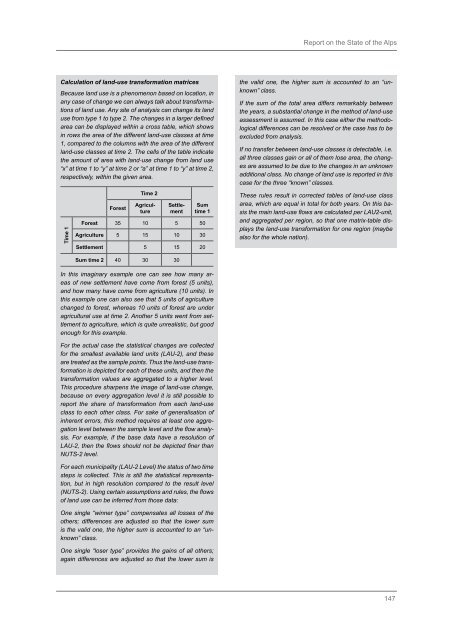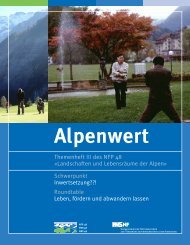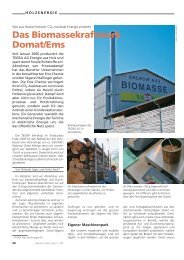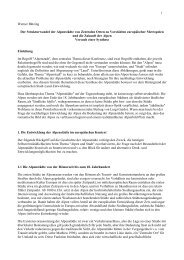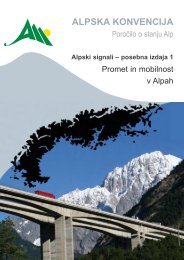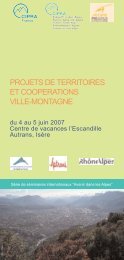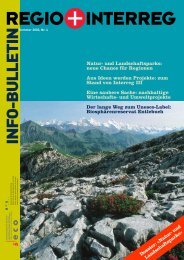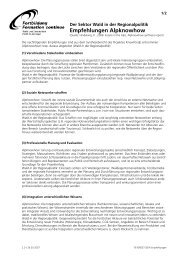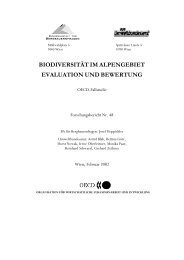English - Alps Know-How - Cipra
English - Alps Know-How - Cipra
English - Alps Know-How - Cipra
You also want an ePaper? Increase the reach of your titles
YUMPU automatically turns print PDFs into web optimized ePapers that Google loves.
Report on the State of the <strong>Alps</strong><br />
Calculation of land-use transformation matrices<br />
Because land use is a phenomenon based on location, in<br />
any case of change we can always talk about transformations<br />
of land use. Any site of analysis can change its land<br />
use from type 1 to type 2. The changes in a larger defined<br />
area can be displayed within a cross table, which shows<br />
in rows the area of the different land-use classes at time<br />
1, compared to the columns with the area of the different<br />
land-use classes at time 2. The cells of the table indicate<br />
the amount of area with land-use change from land use<br />
“x” at time 1 to “y” at time 2 or “a” at time 1 to “y” at time 2,<br />
respectively, within the given area.<br />
Time 1<br />
Forest<br />
Time 2<br />
Agriculture<br />
Settlement<br />
Sum<br />
time 1<br />
Forest 35 10 5 50<br />
Agriculture 5 15 10 30<br />
Settlement 5 15 20<br />
the valid one, the higher sum is accounted to an “unknown”<br />
class.<br />
If the sum of the total area differs remarkably between<br />
the years, a substantial change in the method of land-use<br />
assessment is assumed. In this case either the methodological<br />
differences can be resolved or the case has to be<br />
excluded from analysis.<br />
If no transfer between land-use classes is detectable, i.e.<br />
all three classes gain or all of them lose area, the changes<br />
are assumed to be due to the changes in an unknown<br />
additional class. No change of land use is reported in this<br />
case for the three “known” classes.<br />
These rules result in corrected tables of land-use class<br />
area, which are equal in total for both years. On this basis<br />
the main land-use flows are calculated per LAU2-unit,<br />
and aggregated per region, so that one matrix-table displays<br />
the land-use transformation for one region (maybe<br />
also for the whole nation).<br />
Sum time 2 40 30 30<br />
In this imaginary example one can see how many areas<br />
of new settlement have come from forest (5 units),<br />
and how many have come from agriculture (10 units). In<br />
this example one can also see that 5 units of agriculture<br />
changed to forest, whereas 10 units of forest are under<br />
agricultural use at time 2. Another 5 units went from settlement<br />
to agriculture, which is quite unrealistic, but good<br />
enough for this example.<br />
For the actual case the statistical changes are collected<br />
for the smallest available land units (LAU-2), and these<br />
are treated as the sample points. Thus the land-use transformation<br />
is depicted for each of these units, and then the<br />
transformation values are aggregated to a higher level.<br />
This procedure sharpens the image of land-use change,<br />
because on every aggregation level it is still possible to<br />
report the share of transformation from each land-use<br />
class to each other class. For sake of generalisation of<br />
inherent errors, this method requires at least one aggregation<br />
level between the sample level and the flow analysis.<br />
For example, if the base data have a resolution of<br />
LAU-2, then the flows should not be depicted finer than<br />
NUTS-2 level.<br />
For each municipality (LAU-2 Level) the status of two time<br />
steps is collected. This is still the statistical representation,<br />
but in high resolution compared to the result level<br />
(NUTS-2). Using certain assumptions and rules, the flows<br />
of land use can be inferred from those data:<br />
One single “winner type” compensates all losses of the<br />
others; differences are adjusted so that the lower sum<br />
is the valid one, the higher sum is accounted to an “unknown”<br />
class.<br />
One single “loser type” provides the gains of all others;<br />
again differences are adjusted so that the lower sum is<br />
147


